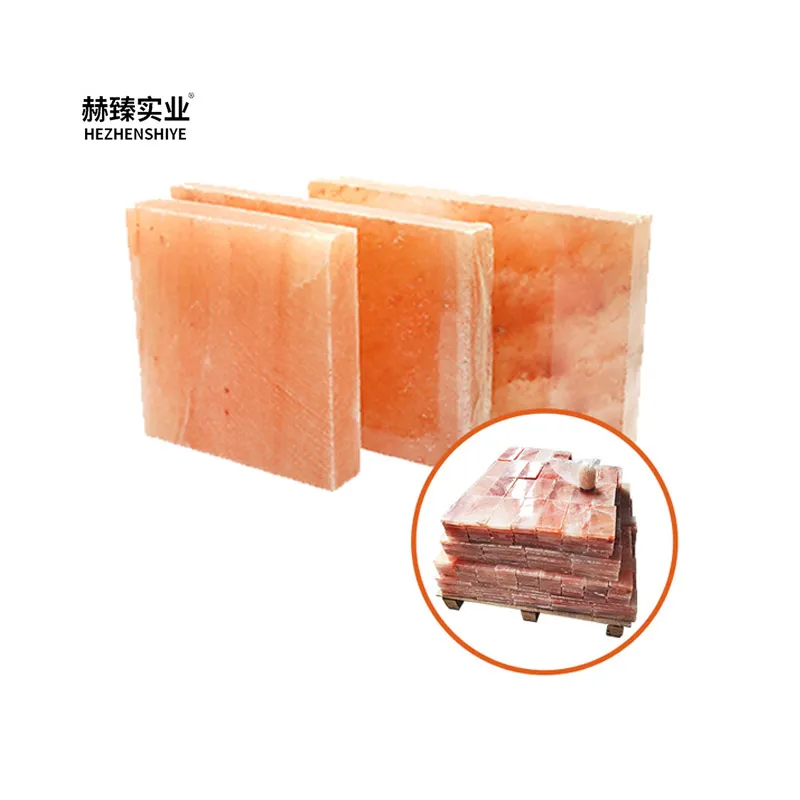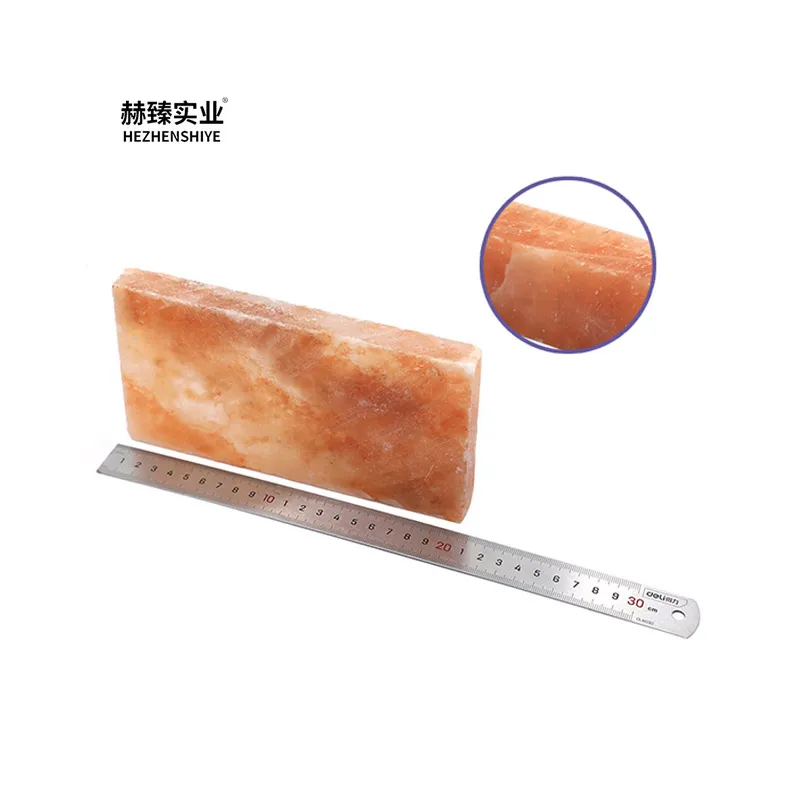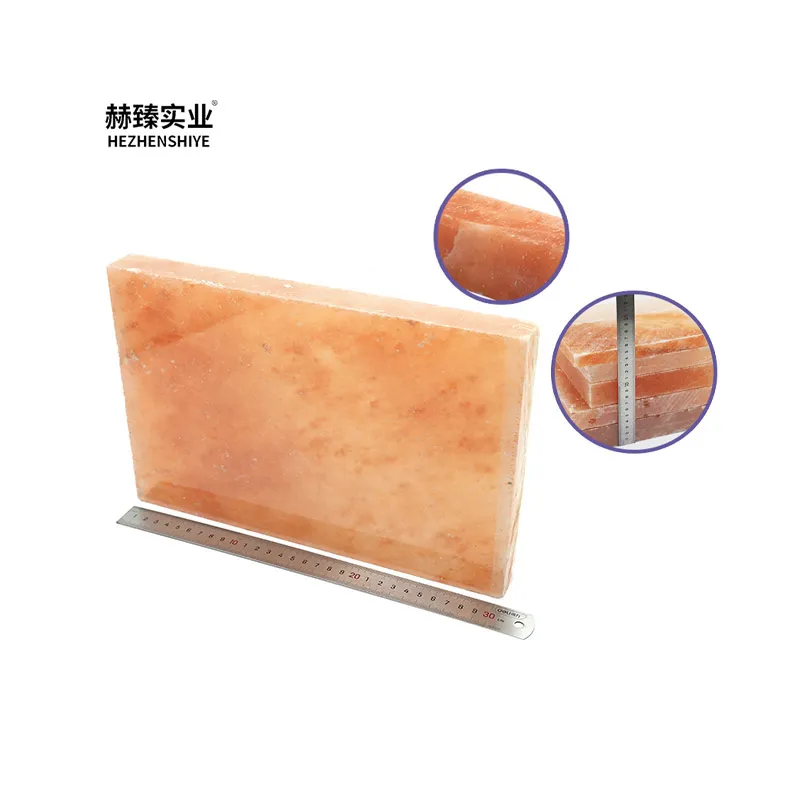Their adaptability to diverse ethnic styles further solidifies their role as ideal choices for cultural museums, ethnic theme restaurants, heritage hotels and other venues where preserving cultural identity and creating immersive, sensory experiences are core priorities. This adaptability stems from their neutral yet warm base properties—they don’t overpower other cultural elements but enhance them. For example, in Central Asian ethnic decor, which often features bold, geometric textiles and metal accents, unpolished Himalayan Salt Bricks with rough textures balance the vibrancy with earthy calm. In Southeast Asian styles that emphasize natural materials like teak and rattan, polished salt bricks with smooth surfaces add subtle luster without clashing. Unlike generic decorative materials that require heavy styling—such as painting or engraving—to fit cultural themes, Himalayan Salt Bricks inherently complement the aesthetic language of many regional cultures. They mirror the warm tones of sun-baked Himalayan village homes, where salt was once mixed into mud walls for durability; they also complement the intricate texture contrasts in South Asian decor, where silk fabrics and carved woods demand a grounding natural element. This inherent compatibility makes them seamless additions that enhance rather than overshadow cultural narratives—whether telling stories of Himalayan nomads, South Asian artisans or Middle Eastern traders.
Cultural museums and exhibition spaces rely on decorative materials that enhance exhibits while conveying historical or cultural narratives, and Himalayan Salt Bricks excel in this dual role. Curators often select these bricks for galleries showcasing Himalayan or Central Asian cultural artifacts, as they create authentic backdrops that feel organic to the exhibits rather than forced. For instance, in a gallery dedicated to Tibetan woolen textiles, salt brick wall claddings in deep amber hues complement the rich reds and blues of the fabrics, while their crystalline texture echoes the mountain light that inspired such textile colors. In exhibits featuring ancient Himalayan pottery, the bricks’ pinkish tones mirror the terracotta clay used in the vessels, creating visual harmony. Their natural texture and color also echo materials used in ancient Himalayan dwellings—where salt was mixed with clay to strengthen walls—helping visitors connect with cultural heritage on a sensory level, not just a visual one. In interactive exhibits designed for families, salt bricks can be shaped into small, child-safe decorative elements like miniature mountain huts or storage jars that visitors can touch (under supervision). This tactile dimension turns passive viewing into active learning, as children and adults alike feel the cool, slightly grainy surface that once was part of daily life for Himalayan communities. Unlike artificial materials like plastic or painted drywall that feel sterile and disconnected from history, these bricks add warmth and authenticity to museum spaces, making cultural exhibits more engaging and memorable.
Ethnic theme restaurants and cafes—focused on cuisines from Himalayan, South Asian or Middle Eastern regions—use Himalayan Salt Bricks to create immersive dining environments that transport guests beyond just taste to full cultural experience. Restaurant owners often invest in covering entire walls or creating decorative partitions with these bricks, as they set the tone for the space more effectively than temporary decor like posters or tapestries. They pair these bricks with other ethnic elements to deepen the theme: in Indian-themed cafes, salt brick walls are adorned with hand-carved wooden spice racks and draped with cotton saris; in Middle Eastern restaurants, they complement brass lanterns and Persian rugs, their warm hues reflecting the glow of candlelight. The natural pinkish tones and crystalline luster of the bricks complement warm lighting—whether from string lights or pendant lamps—creating cozy, inviting atmospheres that reflect regional aesthetics. For example, in a Nepalese-themed restaurant, salt brick accent walls behind dining tables are often backlit with soft yellow lights, evoking the glow of mountain hearths and the rugged beauty of Nepal’s landscapes. This visual connection enhances diners’ culinary and cultural experience, making meals feel like part of a larger cultural journey. Beyond aesthetics, these bricks offer practical benefits critical for restaurant environments: their dense, non-porous surface (when polished) resists food splatters from curries, stews or grilled meats. A quick wipe with a damp cloth removes most stains, avoiding the permanent discoloration that plagues porous materials like unglazed tile. This combination of beauty and practicality makes them a favorite among restaurant owners who want both ambiance and low maintenance.
Heritage hotels, which aim to preserve historical architecture while offering modern comfort, find Himalayan Salt Bricks valuable for blending tradition and functionality in ways few materials can. These hotels often face the challenge of updating spaces without losing historical integrity, and salt bricks solve this by bridging old and new. In hotels located in heritage buildings—such as converted royal residences in Himalayan regions or colonial-era structures in South Asia—these bricks are used to restore or enhance decorative elements that have deteriorated over time. For example, when restoring damaged wall sections in a 19th-century Himalayan palace-turned-hotel, salt bricks are cut to match the size and texture of the original mud-and-salt walls, ensuring the restored area blends seamlessly with the historic structure. Unlike modern concrete or synthetic tiles that would clash with the palace’s original materials, salt bricks maintain the building’s regional character while adding durability that the original mud walls lacked. In heritage hotels in Himalayan foothills, salt brick decorative panels in lobby areas are paired with original stone fireplaces and wooden beams, creating spaces that feel both timeless and comfortable. The bricks’ ability to retain warmth slightly helps keep lobbies cozy during cold mountain winters, reducing reliance on artificial heating. In guest rooms, salt brick accents are used strategically to avoid overwhelming small spaces—headboard panels made from thin, polished bricks add historical charm without crowding beds, while wall strips near windows reflect natural light to brighten rooms. These accents maintain the hotel’s historical identity while providing modern decorative appeal, ensuring guests experience both heritage and comfort during their stays.
Integration of heritage elements is seamless with Himalayan Salt Bricks, as they can be adapted to various cultural design motifs through simple, craft-focused modifications. Craftsmen skilled in traditional stone carving often work with these bricks, as their density allows for precise detailing without cracking. They carve simple ethnic patterns—like interlocking geometric shapes common in Himalayan thangka art, or floral motifs inspired by Mughal architecture—into brick surfaces. These carvings are done by hand rather than machines, preserving the irregularities that give traditional crafts their charm, and the natural color of the salt brick ensures the carvings stand out without needing paint. In venues celebrating multiple cultural heritages—such as community centers that host festivals for Indian, Pakistani and Bangladeshi communities—these bricks act as neutral, natural bases that complement diverse ethnic decor elements. During Diwali, they are paired with rangoli-inspired colored powders and oil lamps, their pink tones enhancing the vibrancy of the rangoli; during Eid, they complement intricate henna designs displayed on tables and brass servingware. For Tibetan cultural events, salt brick walls are draped with prayer flags, their earthy hues balancing the bright reds and blues of the flags. Their ability to bridge different cultural aesthetics comes from their natural, unassuming quality—they don’t claim a single cultural identity but rather serve as a canvas that highlights the uniqueness of each tradition. This versatility makes them go-to choices for multicultural venues like community centers, cultural festivals or university international halls, where inclusivity and respect for diverse heritages are key.
Sustainable building material application is a key advantage of Himalayan Salt Bricks for cultural venues, many of which aim to balance heritage preservation with environmental responsibility as part of their mission to educate visitors on sustainability. As natural minerals mined from existing salt deposits—formed over millions of years without human intervention—they require minimal chemical processing. Unlike synthetic decorative materials like vinyl tiles or fiber-reinforced plastics, which involve petroleum-based chemicals and high-temperature manufacturing, salt bricks are processed using only water for cleaning and mechanical tools for cutting and polishing. This minimal processing reduces carbon emissions by up to 60% compared to synthetic alternatives, according to sustainable building industry reports. Additionally, their durability ensures that decorative elements last for decades—many cultural venues that installed salt bricks 15 years ago report no signs of fading, cracking or wear, even in high-traffic areas. This longevity reduces need for frequent replacements, minimizing waste that would otherwise end up in landfills. Mining operations also follow strict sustainability guidelines: after extracting salt deposits, companies fill excavated areas with local soil and replant native grasses and shrubs, restoring the land to its natural state within five to seven years. Many cultural venues pursue green certification like LEED or BREEAM to demonstrate their commitment to sustainability, and using Himalayan Salt Bricks contributes to credits in categories like “sustainable materials” and “low-emission construction.” Beyond certifications, this choice aligns with cultural values of living in harmony with nature—a principle shared by many Himalayan and South Asian traditions, making the material a symbolic as well as practical choice for venues honoring these cultures.
Preservation of natural hues is another critical trait for cultural theme venues, where color accuracy often ties directly to cultural authenticity and the emotional impact of exhibits or spaces. Himalayan Salt Bricks retain their natural pinkish-amber tones without fading, even under extreme conditions—long-term exposure to bright museum spotlights, humid restaurant kitchens or dry mountain hotel lobbies rarely alters their color. This stability comes from their mineral composition: the pink and amber hues are caused by trace minerals like iron and magnesium trapped in the salt crystals, which are chemically stable and not prone to breaking down under light or temperature changes. This ensures that decorative elements maintain cultural integrity over time, a key concern for venues that aim to preserve traditions for future generations. For example, in a museum exhibit on Himalayan textiles, which often feature specific color palettes tied to regional identities—like pale pinks for spring festivals or deep ambers for winter ceremonies—salt brick walls’ natural colors won’t clash with or overshadow the vibrant fabric hues. Instead, they provide a complementary backdrop that makes the textiles’ colors pop while reinforcing their cultural context. In ethnic theme venues like Pakistani restaurants, where bright orange and green decor reflects national heritage, salt brick walls in soft pink tones balance these bold colors without diluting their cultural significance. Consistent natural colors also help maintain cohesive cultural aesthetics across large venues—for instance, a heritage hotel with salt brick elements in lobbies, hallways and guest rooms maintains a unified, authentic look that feels intentional rather than disjointed. This color consistency ensures that visitors receive authentic, uncompromised cultural experiences, whether they’re viewing a centuries-old artifact or dining on traditional cuisine.






 Banner PDF
Banner PDF Get A Quote
Get A Quote














